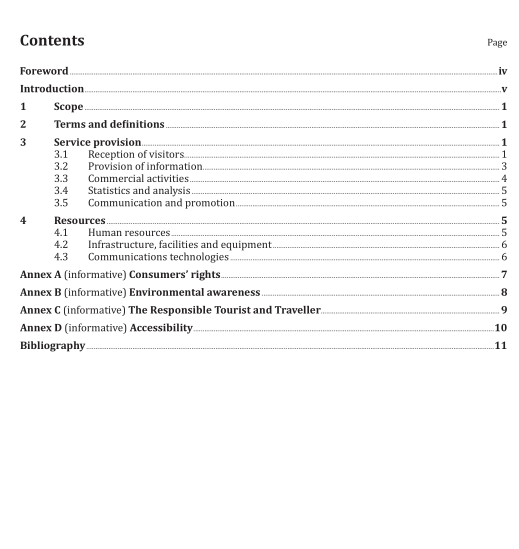BS ISO 14785:2014 pdf download.Tourist information offices — Tourist information and reception services — Requirements
Maps and brochures published by the TIO shall indicate the TIO location.
Parking areas or nearby parking facilities shall be indicated (if available).
3.1.2 Opening times
The TIO shall define and document its opening timetable according to the number of visitors, tourist activities and seasons.
The TIO shall indicate its opening times at the entrance, as well as on notice boards, location maps,answering machines, destination websites (where available) and/or any other media.
Outside normal working hours, information shall be provided by destination websites.
Emergency contacts shall be indicated, clearly visible from the outside to visitors.
A local map shall be visible from the outside.
A list of accommodation with telephone numbers should be visible from the outside, as well as an indication of where this list can be obtained, if possible.
An answer phone message, in at least two languages, shall inform visitors about the opening hours and the website address (see 3.1.3).
3.1.3 Contact
The TIO shall establish, document and communicate to staff the expectations with respect to behaviour etiquette and crowd management.
Staff shall look professional and provide an efficient service, and shall show they are available and welcoming by:
a) initiating conversation with a greeting;
b) being patient;
c) being polite and friendly;
d) giving priority to visitors over administration work or any other task;
e) clarifying visitors’ enquiries in order to provide a satisfactory response;
f) taking leave with a greeting.
Staff shall be easily identifiable, by means of their clothing or appropriate badges, etc.
The TIO shall choose and justify the languages understood and spoken at the reception desk, as well as on answering machines and websites. This choice shall correspond to the expected profile of international visitors and shall include at least one international language.
NOTE Staff are expected to communicate with visitors in the language chosen by the visitor, if possible.
The TIO shall establish a tool to enable visitors to identify the languages spoken by each person of the staff.
3.1.4 Call and mail handling
All visitors shall receive the same treatment, whether they visit the TIO in person or not.
TIO contact information shall be widely promoted using the available means of communication.
The TIO shall establish a telephone calls handling procedure. This procedure shall define the time limit between the first ring and the transfer of the call to a member of staff. If the defined time limit is exceeded, a message shall explain how to contact the TIO (via the web, by e-mail) or shall give visitors
the option of leaving a contact number.
NOTE 1 If possible, calls are answered before the fourth ring and calls are transferred to a staff member within 40 s.
NOTE 2 It is not advisable to put a caller on hold with music for too long. If possible, priority is given to visitors in person, especially when there is only one employee.
If a caller leaves a contact number on the answering machine, a call back should be made within 30 min during opening hours. If the caller is put on hold, regular contact shall be maintained to enable him/her to either wait, call back or be called back (at the caller’s request).
Recorded messages shall be processed and answered every working day. Letters shall be processed and answered within three working days. E-mails shall be processed and answered within two working days.
3.2 Provision of information
3.2.1 Information for visitors
Information shall be accurate and regularly updated. The TIO shall consider only tourist providers meeting appropriate legal and regulatory requirements.
Information shall be available on a broad range of topics.
NOTE The topics can include accommodation, travel agencies, eating out, transport, cycle routes, shopping,local products and crafts, walks, cultural activities, holidays, heritage and sports activities and outdoor pursuits,banks, currency exchange, tax free conditions, chambers of commerce, local customs, religion and places of worship, libraries, medical services, police and post offices, real estate agencies, local and regional attractions,and weather forecasts.
The TIO shall have general and specific information about the destination and about tourist attractions,with the necessary details for the visit: location, description, features, conditions and opening hours.
The TIO shall have details of the day, time, place of performance and content for events and activities carried out at the destination (recreational, cultural, sporting or leisure).
Information shall take account of the interests of children and the needs of people with disabilities.
The TIO shall give information to visitors about health, safety and good practices to help them to enjoy the area.
For safety reasons, and in order to avoid risks to visitors, the TIO shall provide appropriate information about drinking water, high and low tides, the presence of poisonous plants, other local dangers that might be encountered, etc.
The TIO should provide a website and or other electronic support with such information.
The TIO shall give information to facilitate the visitors’ choice (see Annex A).
The TIO should also provide tourism information at national level or indicate how to obtain it.
If commercial leaflets and brochures are displayed, they shall be separated from the TIO information.
If the TIO has unmanned information service points, they should provide the same items.
There shall be an indication of materials which shall be paid for as well as indication of the price.
The TIO shall give written information, either printing it on demand or making it possible to take notes.
The TIO should offer information in several forms, trying to avoid unnecessary printing (see Annex B).BS ISO 14785 pdf download.BS ISO 14785 pdf download
